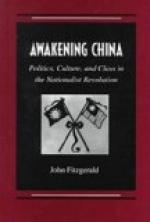The most eminent of the five philosophers was Chu Fu-tse. Not the most original, he collected the best thoughts of all into a system; and his erudition was such that the whole range of literature was his domain. Chu Hi, the Coryphaeus of mediaeval China, stands next in honour after that incomparable pair, Confucius and Mencius. Contemporary with the earlier members of this coterie appeared Wang Ngan-shi, an economist, of rare originality. His leading principle was the absorption by the state of all industrial enterprises—state ownership of land, and in general a paternal system to supersede private initiative. So charming was the picture presented in his book “The Secret of Peace” (still extant) that the Emperor gave him carte blanche to put his theory into practice. In practical life however it was a failure—perhaps because he failed to allow for the strength or weakness of materials and instruments. His book is a Chinese [Page 129] Utopia, nearly akin to those of Plato and Sir John More.
In the northeast beyond the Wall were two Tartar kingdoms, one of which was the Kin or “Golden Horde”—remote ancestors of the Manchu dynasty. A constant menace to the settled population of the “inner land,” they obtained possession of Peking in 1118. For a time they were kept at bay by a money payment which reminds one of the Danegeld paid by our forefathers to the sea-robbers of northern Europe. Payments not being punctual, the Tartars occupied portions of the northern provinces, and pushed their way as far south as K’ai-fung-fu, the capital of the Empire. The Emperor retired to Nanking, leaving in command his son, who, unable to resist the Tartars, made a disgraceful peace. A heavy ransom was paid to avert the sacking of the city; and all the region on the north of the Yellow River passed under Tartar sway.
Repenting of their hard bargain, the Chinese provoked a renewal of hostilities, which resulted in a heavier downfall. The capital surrendered after a severe siege, and the Emperor with his court was carried into captivity. The next emperor acknowledged himself a vassal of the Tartars; but peace on such conditions could not be of long duration. An intermittent warfare was kept up for more than a century, in the course of which Nanking was pillaged, and the court fell back successively on Hangchow and Wenchow. When there was no longer a place of safety on the mainland the wretched fugitives sought refuge on an island. Fitting out a fleet the Tartars continued the [Page 130] pursuit; but more used to horses than ships, the fleet was annihilated, and the expiring dynasty obtained a new lease of life.
This was about 1228. The Mongols under Genghis Khan and his successors had carried everything before them in the northwest. Thirsting for revenge, the Chinese appealed for aid to this new power—and the Mongols found an opportunity to bag two birds instead of one. As a Chinese fable puts it: “A sea-bird failing to make a breakfast on a shellfish was held in its grip until a fisherman captured both.”




